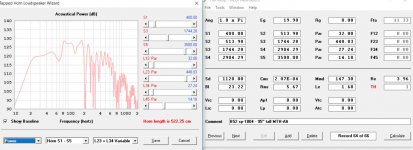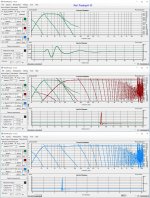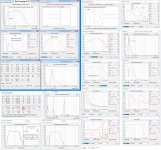at one time they also had 18" driver folded horns
B-52 Professional LX-Series: Active & Passive Folded Horns
For an example of using a capacitor with a sealed box - here's that B52 18 in a 60 liter sealed box with 525uF and driven by a high damping factor amp

B-52 Professional LX-Series: Active & Passive Folded Horns
For an example of using a capacitor with a sealed box - here's that B52 18 in a 60 liter sealed box with 525uF and driven by a high damping factor amp

at one time they also had 18" driver folded horns
B-52 Professional LX-Series: Active & Passive Folded Horns
For an example of using a capacitor with a sealed box - here's that B52 18 in a 60 liter sealed box with 525uF and driven by a high damping factor amp

B-52 Professional LX-Series: Active & Passive Folded Horns
For an example of using a capacitor with a sealed box - here's that B52 18 in a 60 liter sealed box with 525uF and driven by a high damping factor amp

Looks like it would work really well for sound reinforcement in a sealed box that way, not so much for maximal extension. Gonna have to scrap the cap idea in the reflex, though, looks like a really good way to pull the former out of the gap...
@Djim:
I asked you to clarify your position, things like assuming heavy motor losses on magnet weight alone are pretty vague. I've never heard of how Zmin raised above Re is going to screw with the entire response of a cabinet.
I have been under the impression that Eddy currents are more of an issue as frequency raises and are sources to all kinds of distortion. You are however talking about a mayor influence at the 1/4 wavelength (acoustic impedance) which is about as low as it could be. I've never found an article about that.
Considering the wide spread use of 1/4 wavelength resonance in diy audio, this sounds like something the diy community should be aware of, I for one would love to know the principle behind it.
PS. I'm aware that you have send me a PM but it basically said read everything from people about large scale parameters and about the method of Douglas J. Button and later Klippel.
Which to me (a non-AES memeber by the way) sounds just as vague.
I look forward to anyone able to shed some light on this.
I asked you to clarify your position, things like assuming heavy motor losses on magnet weight alone are pretty vague. I've never heard of how Zmin raised above Re is going to screw with the entire response of a cabinet.
I have been under the impression that Eddy currents are more of an issue as frequency raises and are sources to all kinds of distortion. You are however talking about a mayor influence at the 1/4 wavelength (acoustic impedance) which is about as low as it could be. I've never found an article about that.
Considering the wide spread use of 1/4 wavelength resonance in diy audio, this sounds like something the diy community should be aware of, I for one would love to know the principle behind it.
PS. I'm aware that you have send me a PM but it basically said read everything from people about large scale parameters and about the method of Douglas J. Button and later Klippel.
Which to me (a non-AES memeber by the way) sounds just as vague.
I look forward to anyone able to shed some light on this.
I as well, it certainly sounds like an interesting topic for exploration. I don’t mind having it on this thread, but that’s the kind of thing that seems in-depth enough that it might merit its own post. If a thread gets started, I look forward to it!
Looks good in the desired passband, nasty spikes just above it though. I’ll be using LR2 LP filters, though, so there would still be a lot of acoustic power getting through in the 100-120 range, maybe on up to 200. Wouldn’t be an issue in a pair, but could cause significant soundstage anomalies with a single corner-placed sub.
Hmm, short of a full on compression horn or large, well damped TL, LR2 with this driver, desired BW pretty much limits you to simple reflex, sealed alignments and room/corner gain to get 'flat' to 20 Hz in room at some reasonable amount of efficiency.
The TQWT I considered posting is ~375 L and limited to 80-90 Hz with just 2nd order, though Xmax limited to 80 W sims a minimum ~118 dB/m/1pi from 20 Hz-up.
GM
The TQWT I considered posting is ~375 L and limited to 80-90 Hz with just 2nd order, though Xmax limited to 80 W sims a minimum ~118 dB/m/1pi from 20 Hz-up.
GM
I think I’m gonna end up going with the 170l 6th order that Freddi posted, the response looks fairly flat in the target bandwidth. Simple construction is a plus, too.
@ snappyturtle
Looks quite good to me, for 20Hz - 80HZ
@ GM
Your 375Ltr sounds good too, So please post it
Looks quite good to me, for 20Hz - 80HZ
@ GM
Your 375Ltr sounds good too, So please post it
larger FL TH = gain as expected 🙂
but consider the 170 liter reflex in 6th order mode with 16Hz HP and 6dB/Q=2 peaking at fb - - that takes more amplifier power as a tradeoff but only in that one narrow region
FWIW I think theater organ recordings would sound "ok" on the eq-ed reflex
and the TH is a bit over double its size - and the reflex has less excursion from 25-~40Hz
(and less in the sub-20 region)
I wish EQ-boxes for 6th order reflex were available - wouldn't take much circuit or cost wise

but consider the 170 liter reflex in 6th order mode with 16Hz HP and 6dB/Q=2 peaking at fb - - that takes more amplifier power as a tradeoff but only in that one narrow region
FWIW I think theater organ recordings would sound "ok" on the eq-ed reflex
and the TH is a bit over double its size - and the reflex has less excursion from 25-~40Hz
(and less in the sub-20 region)
I wish EQ-boxes for 6th order reflex were available - wouldn't take much circuit or cost wise

Last edited:
At the end outfoxhyperion must measure the driver with rew when its delevered, and with the real t/s and the semi inductance values all we´ll can make better simulations 😀
I’m probably going to end up going with the 6th order reflex, as I’m willing to trade off a little bit of sensitivity and ultimate SPL for the sake of maximal flat extension and improved cone control. As of right now, though, I don’t have any measurement tools available so I’ll have to trust the manufacturer published specs. If anybody has any measuring tools they’re looking to part with, though, feel free to PM me...
That's an interesting bit of kit, does SW work with Windows 10? As I was reading I saw that he said some users had a hard time installing it on 7, so it seems like more problems still might be had with 10. Of course, if that rig can be used with other software that negates that concern entirely.
So, since PE just put the Dayton 250W sub amp with built in DSP on sale for, $175, I think I'm actually going to use that for amplification and tuning:
Dayton Audio SPA250DSP 250W Subwoofer Plate Amplifier with DSP
With that bit of knowledge, should I still proceed with the 6th order reflex or maybe go with a large sealed alignment and do something like a LR transform to keep it flat to 20 Hz? Reading the reviews, it looks like the built in subsonic filter only goes as low as 25 Hz, so using filtering to prevent overexcursion on subsonic content with this amp isn't an option.
Dayton Audio SPA250DSP 250W Subwoofer Plate Amplifier with DSP
With that bit of knowledge, should I still proceed with the 6th order reflex or maybe go with a large sealed alignment and do something like a LR transform to keep it flat to 20 Hz? Reading the reviews, it looks like the built in subsonic filter only goes as low as 25 Hz, so using filtering to prevent overexcursion on subsonic content with this amp isn't an option.
- Status
- Not open for further replies.
- Home
- Loudspeakers
- Subwoofers
- Buyout B-52 18" for HT use?




